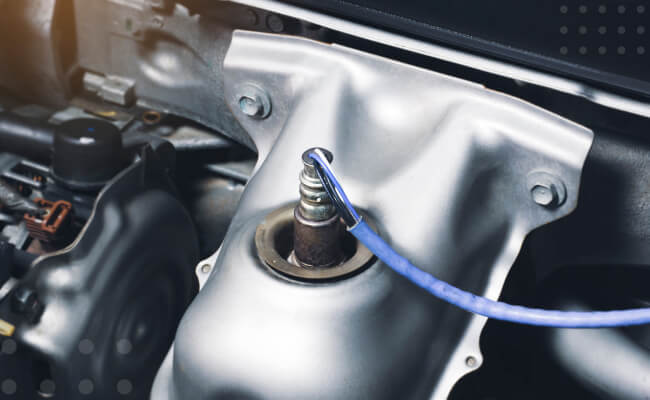| COMPONENT LOCATION |

| GENERAL DESCRIPTION |
In order to control emissions of the CO, HC and NOx components of the exhaust gas, heated oxygen sensor (HO2S), mounted on the front side and rear side of catalytic converter, detects the oxygen content in the exhaust gas. The front HO2S signal is used to control air/fuel ratio (closed loop fuel control) and the rear HO2S signal is used to monitor front HO2S and catalyst for proper operation. The HO2S requires a minimum temperature to operate properly and provide a closed loop fuel control system. The HO2S contains the heater element to reduce its warming-up time and ensure its performance during all driving conditions. The oxygen sensor generates a voltage that indicates the difference between the oxygen content of the exhaust stream and the oxygen content of ambient air. When the exhaust stream is “rich,” there is more oxygen in the ambient air than in the exhaust stream, so the voltage will be higher.
| DTC DESCRIPTION |
Checking output signals from HO2S under detecting condition, if ECM judges it’s signals too slow, ECM sets P0133.
| DTC DETECTING CONDITION |
| Item | Detecting Condition | Possible Cause | |||||||||
| DTC Strategy |
|
| |||||||||
| Enable Conditions |
| ||||||||||
| Threshold value |
| ||||||||||
| Diagnosis Time |
| ||||||||||
| MIL On Condition |
|
| SPECIFICATION |
| A/F Ratio (λ) | Output Voltage (V) |
| RICH | Min. 0.8 |
| LEAN | Max. 0.1 |
| DIAGNOSTIC CIRCUIT DIAGRAM |

| SIGNAL WAVEFORM & DATA |



Fig.1) Normal graph of upstream HO2S and downstream HO2S at idle.
Fig.2) Normal waveforms of upstream HO2S(the upper) and downstream HO2S(the lower) (chassis ground used)
Fig.3) Normal waveforms of upstream HO2S(the upper) and downstream HO2S(the lower) (sensor ground used)
After warming-up, if accelerator pedal is released suddenly around 4000rpm, the HO2S signal reading will be lower than 200mV resulting from Fuel cut-off for the moment. Conversely, if suddenly accelerator pedal is depressed, HO2S signal reading will be around 0.6V ~1.0V. At idle, Normally HO2S signal will switch from lean to rich with 3 Hz. And as racing, Its frequency rises.
| MONITOR GDS DATA |
| 1. | Connect GDS to Data Link Connector(DLC). |
| 2. | IG “ON”. |
| 3. | Select “DTC” button, and then Press “DTC Status” to check DTC’s information from the DTCs menu. |
| 4. | Read “DTC Status” parameter.
|
| 5. | Is parameter displayed “Present fault”?
|
| COMPONENT INSPECTION |
| 1. | Replace the HO2S. |
| 2. | Clear DTC with GDS. |
| 3. | Start the engine and warm it up until the radiator fan comes on(more than at least 10 minutes). |
| 4. | Drive at a steady speed between 45-55 mph(72-88 km/h) for 120 sec. |
| 5. | Stop and then maintain idle state. |
| 6. | Check if O2 sensor monitoring readiness is complete. |
| 7. | Does the GDS show DTC P0133?
|






Comments are closed